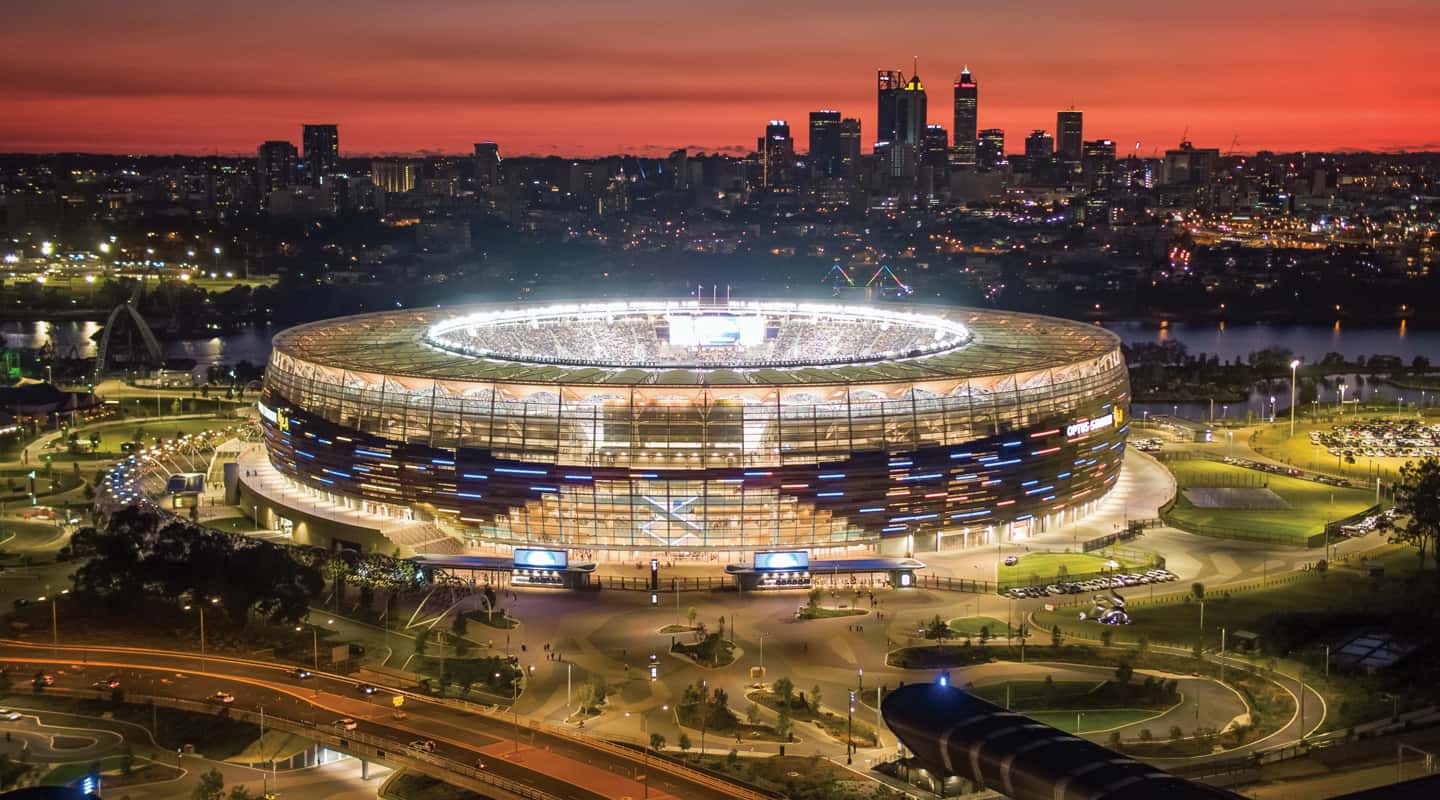
West is Best?
Perth’s Optus Stadium is off-the-hook amazing.
Text:/ Derek Powell
Perth Stadium, or now, Optus Stadium, thanks to a rumoured $50m naming rights deal, is Australia’s newest major sporting venue and the third-largest sporting stadium in the country by capacity, with 60,000 seats. The facility, owned by the Western Australian State Government, was officially opened on Sunday 21 January 2018 after a four-year construction program. And it was worth the wait. The venue has already hosted several major sporting events including One-Day International Cricket, Big Bash, Rugby League, and Rugby Union; plus two sold-out Ed Sheeran concerts; and of course a dozen AFL games, in less than six months.
At a reported cost of $1.6b, everything about this venue is massive. The stadium boasts two of the biggest screens in the southern hemisphere, plus more than 1000 displays spread throughout the interior, however it has not come without some challenges during the design and build phase.
MAN OF STEELE
The entire complex was built by Multiplex under a design, build, finance and maintain (DBFM) contract. The original audiovisual specification was developed by consultants Marshall Day with Rutledge AV taking over the responsibility for construction delivery. Elijah Steele (Rutledge AV Project Manager) spent three years immersed in the project right from the extensive workshopping phase with the myriad potential users to the final handover, so he was in a great position to recall the inside story.
“While we obviously took note of Etihad Stadium, the MCG, and, of course, the Adelaide Oval, we tried to take a ‘clean slate’ approach, because the outcome Optus Stadium wanted was a ‘fans first’ experience in a multi-purpose stadium,” Elijah explained. “A stadium used for so many different sports events, as well as concerts and everything else is quite rare. There are not many other stadiums around Australia that can support that.”
To make sure everything was taken into consideration, the stakeholder engagement was extensive — encompassing peak bodies, such as AFL Australia and Cricket Australia; the West Coast Eagles and the Fremantle Dockers and the broadcast users (NEP and the in-house production facility).
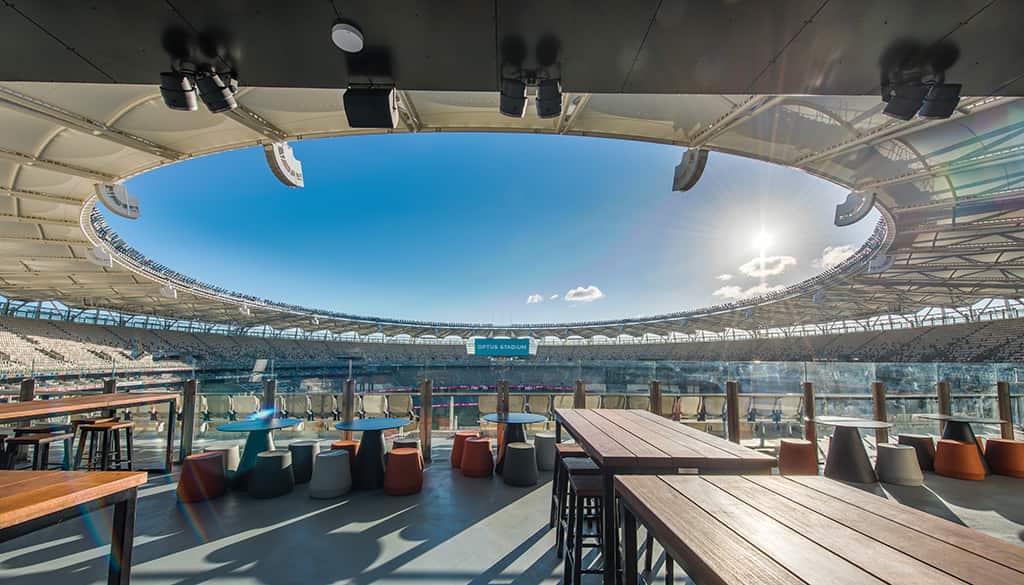
KNOW THE GAME
Before embarking on the detailed design, the Rutledge AV team needed to understand the real nuts and bolts of game-day operations. It is surprising just how much AV equipment is required for such a large modern sporting facility. One hub of activity are the coaches’ boxes — for both the home and away teams. This includes communicating with the interchange bench and briefing room, dialling up video from the medical room and acquiring viision and audio links integrated into the warm-up rooms.
At many venues, these facilities have been enabled by patching, but the Rutledge AV design for these facilities is based around a touchscreen-controlled 32×32 Crestron matrix switcher to support specific video feeds — a quantum leap into the future and one that has been enthusiastically embraced by the tech-savvy coaching staff. However, there is much, much more to the story than this.
Elijah explained that there are several major sub-systems within the AV infrastructure. First, there is the broadcast infrastructure: facilities used either by the broadcasters or the in-house production facility transmitting to the in-house screens, corporate facilities, bowl PA and the massive LED scoreboard screens.
Then there are the ‘Premium AV’ spaces which include the corporate boxes, game-day suites, function rooms, terrace bars and the executive level dining rooms located around the stadium. The facilities for the teams include the warm-up areas and coaches’ boxes.
Finally, there are the PA systems, including the enormous bowl PA and the general PA system covering back of house, concourse, bus station, train precinct, ticket booths and some of the outdoor areas. Almost as an afterthought, Elijah revealed that there are over 1500(!) speakers, just in the general PA alone.
HIGH IN FIBRE
Rutledge AV’s brief started with the backbone cabling around the entire stadium for all broadcast facilities, including internal production.
“The three main locations include the OB compound, which is obviously essential, the main communications room and the production room,” Elijah revealed.
“The majority of the infrastructure goes directly back to the OB compound, which is a massive facility with over a thousand ties. We also have fibre infrastructure feeding the Master Control Room and the Production Suite. Essentially you have a massive star configuration with a redundant ring between the key locations where feeds can be distributed all around the stadium. Broadcast field points can be shared between the broadcasters and in-house production at certain locations rather than separating the infrastructure as has been the design intent in the past. It’s almost network-based,” explained Elijah.
The video format is predominantly 3G SDI often carried on SMPTE 311 M hybrid fibre/copper cables. “We installed fibre at every single location,” Elijah noted. “All the locations do have other cable infrastructure as required but the fibre is there due to the distance and the future proofing that it offers.
“These days, broadcast production units have fibre converter boxes for nearly everything. We have multiple fibre cores at any one location so the infrastructure can be used for video or audio and can enable future expansion of specific network connectivity. A fibre design offers substantial future proofing so that’s where everything is heading.”
ON THE TANNOY: INSTALLED AUDIO
- More than 400 premium Tannoy CMS503 ICT-LP and 240 x CVS6 in-ceiling loudspeakers are installed in the hospitality suites. More than 300 premium AMS6 ICT and 120 x AMS8 DC surfacemount loudspeakers are installed in the general seating and undercover concourse areas.
- 60 x OCV hanging pendant loudspeakers are installed in the food concession areas of the stadium.
- 140 x VLS15 and VLS30 column speakers are installed in the general outdoor concourse areas, walkways and rail platforms
- More than 100 compact lab.Gruppen Lucia 120/2M amplifiers are installed in the hospitality suites and corporate boxes which are integrated and controlled via RS-232 with the site-wide AV control system.

STADIUM LED HALL OF FAME
Daktronics dominates the Australian stadium LED screen market — with screens in 18 of the most significant stadiums. The two in Perth Stadium are the biggest stadium screens in the country.
Perth Stadium: 10.24m x 33.28m
Melbourne Cricket Ground: 13.17m x 25.24m
Sydney Cricket Ground: 10.97m x 24.87m
Adelaide Oval: 9.88m x 18.65m
Etihad Stadium: 6.58m x 12.8m
Skilled Park Stadium: 5.85m x 10.24m
SUITE AS
The roster of ‘premium AV’ spaces includes 102 suites around the stadium, which are classed as corporate game-day facilities. Each suite comprises screens with access to local HDMI sources as well as the in-house IPTV system. Separate audio systems will allow patrons to play their own music or select the various video soundtracks. Each suite is managed by an integrated controller which operates the lights, in-room music, selects between the multiple HDMI inputs, and commands the in-house IPTV system.
Suites are only part of the Premium AV story. There are huge dining spaces, one of which can split into three function rooms. Local video feeds, IPTV or game-day feeds can be displayed on a pair of 200-inch projection screens, with audio handled by Tannoy VLS30 column speakers matched with dedicated subwoofers. The broadcast infrastructure extends throughout the function area providing presentation points that can be used for local broadcasting. Rounding out the function areas is the exclusive Chairman’s Club which even has its own dedicated video conferencing facility.
BOWL OF PLENTY
In a stadium, the main PA system (or bowl PA as it is referred to) is always going to present challenges — and this was no exception. The Rutledge AV crew really had to pull out all stops to create a super sound to go with the stadium’s two massive Daktronic screens — more on those later. Rutledge AV started from a specification provided by the State, which posed some very challenging performance criteria.
The brief called for a Speech Transmission Index (STI) of 0.6 across the seating areas with the capability to achieve 102dB at the seating level (to rise above the noise of a boisterous crowd). So they set to work with an EASE modelling system and worked backwards to arrive at a suitable hardware solution. The system chosen was based on Nexo GEO S-12 components and local support for the brand was crucial.
“Nexo was obviously a very good system, with both the clarity needed and the power to perform to the expected criteria,” Elijah explained. “But also the local Australian supplier of Nexo, Group Technologies, has a very good understanding of the structural components and had some pretty savvy design around how the line arrays could be housed. So they worked very closely with us to deliver those structural components which were a big part of installing the bowl PA system.”
Getting the structural and mounting issues right was crucial, as Elijah explained: “By the time we got to the point of detailed design,” he recalled, “the stadium itself had been in design for three or four years. The roof structure and everything else had already been manufactured. So having decided that line arrays were the best solution to the acoustics, we faced very strict criteria around where we could suspend them, since the roof structure was nearly all fabric.”

BIG SCREENS, BIG UNDERTAKING
The impressive LED displays in the bowl are a story unto themselves.
The Daktronics displays themselves are 10.24m by 33.28m (some 8 million pixels, all up) but the horsepower and manpower behind these monsters is even more impressive.
The turnkey contract with Brookfield Multiplex was for the design, build, installation and maintenance for all LED displays and control system at Optus Stadium. The sheer scale and complexity of the operating functionality and integration with the audiovisual system is by far the most advanced and complicated installation within Australia.
To give a sense of the job at hand, Daktronics Australia’s Blair Robertson shared the extent of the manpower involved over the course of the installation and three-month commissioning phase:
- 3 full time project managers
- 10 full time installers, 12 months on site
- 2 mechanical engineers
- 1 electrical engineer
- 1 thermal engineer
- 1 programmer
Rather than being a couple of digital scoreboards, or ‘dumb’ endpoints for content, the Daktronics control system (the Venus Control Suite) provides a single point of control for all LED and IPTV displays throughout the complex.
The control suite was tweaked to send triggers to the sound and lighting system providing a synchronised presentation for the Philips lighting and audiovisual set pieces. The Venus Control Suite also allows the stadium to access diagnostics status for any LED display within the system (including remote access).
Using Real Time Data (RTD) integration with Champion Data, the Daktronics can display the latest stats from other games of interest to patrons including AFL, cricket, rugby union/league and soccer.
PA & CAN-DO RIGGING
The upshot? The only available point for suspension of the heavy speaker arrays was the very tip of the roof structure 45 metres above the ground — well out of reach of conventional access techniques. The structural engineers were called in to assist in designing the mounting but they also faced another hurdle. To allow for the line arrays to be serviceable, they had to be suspended in such a way that the massive assemblies could be dropped down to the seating level for maintenance.
The solution was ingenious, but challenging. Rutledge AV and the team designed and manufactured a custom mobile dolly, which is housed permanently in the roof structure. The dolly is equipped with a two-tonne winch and can move around to each speaker stack, attach to it, and drop the entire line array down to the Level 1 seating area, where it can be maintained.
The speakers are a passive design, so meaty 6mm figure-8 cables snake through the structure from the speakers at the tip of the gantry to the amplifier racks on level 5. All sound in the stadium travels across a fully converged network via Dante and QLAN, under the control of Q-Sys. The Q-Sys system is broken up into two separate components. While Q-Sys is the backbone, distributing audio stadium-wide, it is also the core component in each of the premium AV areas. These are standalone with a Q-Sys core dedicated to the rooms but draw content from the wider system carried on the network, everything from commentary to the background music channels. Every aspect of the audio and each individual room can be scrutinised via the Q-Sys monitoring system which makes identifying and dealing with problems much more efficient.
PRODUCTION SUITE
At the centre of the action on game days is the production suite. On the audio front, a Yamaha CL-5 handles the mixing tasks but there’s a lot more going on as well. The heart of the production suite is a 128×128 HDSDI routing switcher which integrates video sources from around the stadium via the broadcast infrastructure and routes video feeds to all the production stations, the team facilities and the corporate suites as well as to the twin stars of the video firmament, the two 340sqm Daktronics ‘Super Screens’ at each end of the ground.
While in the individual areas such as the coaches’ boxes and the premium suites, Crestron control systems call the shots, the action on screen and in the stadium is managed by a separate Daktronics custom show control system. When the West Coast Eagles run out onto the field, the director triggers a preset on the Daktronics Show control that calls lighting scenes both within and outside the stadium, cues the audio and switches vision to the super screens for an all-enveloping ‘fans-first’ experience.
The entire stadium audiovisual experience is a tribute to the many people and companies who made it happen from the builders Multiplex to consultants Marshall Day and AECOM, not forgetting the pivotal role of Rutledge AV. It is also a reminder to the rest of the country of the capabilities of our Sandgroper cousins. As Premier Mark McGowan remarked at the official opening: “The build here, the finish, the extraordinary design shows that West Australians, and the West Australian industry can do anything.”
GEAR HIGHLIGHTS
- Nexo GEOS Bowl PA & amps
- QSC CXD QLAN amps x 55
- QSC processors – 2 x Cores & 8 x DSPs
- Tannoy install speakers x 1200
- Lab.gruppen amplifiers x 102
- Crestron DigitalMedia
- Yamaha CL Series Mixing Consoles
- Yamaha Dante I/O
- Sennheiser Wireless
- Genelec monitors
- Blackmagic audio monitoring
- Panasonic 4K IP PTZ Cameras
- Panasonic PT-RZ790 laser projection
- Extron DTP Distribution Amps
- Lectrum Aero lecterns (pictured)
KEY RUTLEDGE AV PERSONNEL
Elijah Steele
Rob Di Tella
Fernando Barreiro
Ross Fowler
Kamila Marcinczak
Lina Will
Gavin Wright
Alistair Dick
Matt Edgcumbe
Ryan Agostino
Rob D’Agostino
Adam Gregory
David Conner


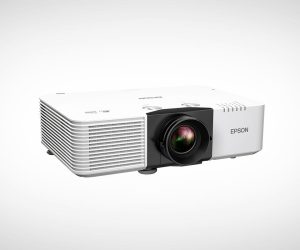
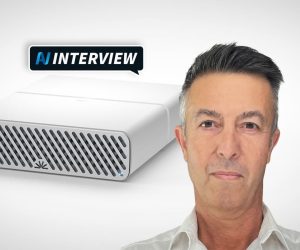

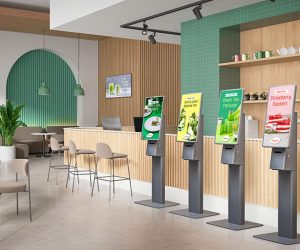
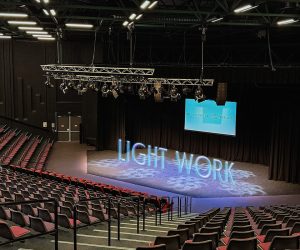

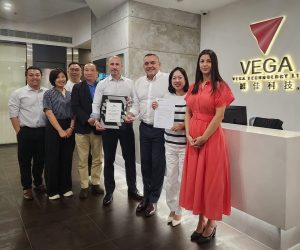
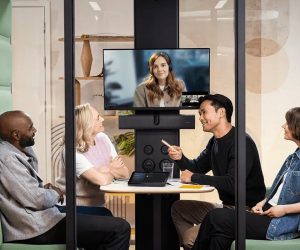
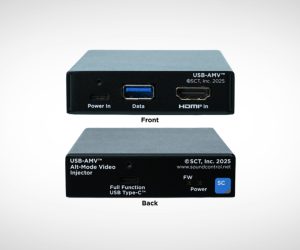

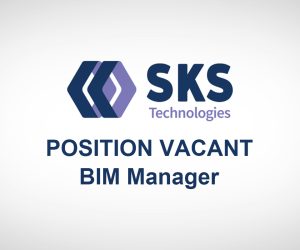


RESPONSES